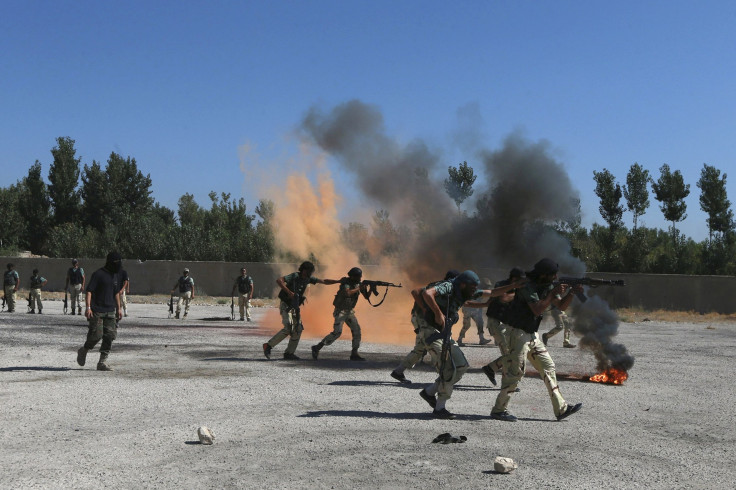What The US Campaign Against ISIS May Look Like: Jets, Drones, Special Forces, And Allies

After Barack Obama’s vow to eradicate ISIS in Syria in an address Wednesday evening, there has been increased speculation about what military assets the U.S. will use against the group it has been hitting with airstrikes in Iraq. The U.S. could ramp up its air campaign using aircraft based on land in the region, or on aircraft carriers in the Persian Gulf or the Mediterranean. Obama repeated the assertion that no boots would be on the ground -- and the claim may have already been disproven by the reality of the fight against the terrorist militia, in which the U.S. has already employed special forces, inside Syria.
Just one day after a video depicting the beheading of American journalist James Foley was made public by ISIS on Aug. 19, Obama’s counterterrorism adviser admitted that a rescue attempt by U.S. Army Delta Force soldiers looking for Foley and Steven Sotloff, another journalist, had been unsuccessful. They were using information obtained from former ISIS hostages, held with the Americans, who had been released.
The raid by those special forces, just outside Raqqa, Syria, in early July offers some help explaining what Obama plans for ISIS in Syria, according to Jay Carafano, a national security expert at the Heritage Foundation in Washington. Special forces teams inside Syria and Iraq could, at least, help direct airstrikes better than drones or satellites could.
“The eye in the sky is not enough,” said Carafano. “It’s tactically better when you’ve got people on the ground to look and confirm what’s really going on. The great thing about ISR [intelligence, surveillance and reconnaissance] is you can direct other assets to go and look at something, but ...onlyy looking through the soda straw of a drone or the satellites is simply not enough.”
Obama’s speech on Wednesday outlined a strategy of bombing ISIS, including within Syria, as well as using a mixture of intelligence, training for rebel fighters, and increased support for local forces on the ground that oppose ISIS.
“America will lead a broad coalition to roll back this terrorist threat,” he said in his address. “Our objective is clear: We will degrade, and ultimately destroy ISIL [another name for ISIS] through a comprehensive and sustained counter-terrorism strategy,” the president said.
The countries that have committed to help are Britain, Germany, France, Denmark, Poland, Australia and Saudi Arabia. Secretary of State John Kerry is in the Middle East to seek new partners for the coalition.
As for what the U.S. and coalition members willing to use force will actually do militarily, “it's quite likely that phase two will see less cruise missiles and more involvement by tactical planes from land bases and aircraft carriers,” said David Cenciotti, owner of the Aviationist website, which reports on military aviation issues.
Currently, the U.S. is using Navy F-18 jets from an aircraft carrier in the Persian Gulf and possibly also Air Force F-15s, which may be based in Qatar, to hit ISIS in Iraq.
Obama said Wednesday that one allied nation is taking part in airstrikes, but he did not say which. U.S.-allied nations in the region with the capability to conduct precision airstrikes include Turkey, whose F-16 jets are based very close to the Syrian border; the United Arab Emirates, which may have already demonstrated the capacity and willingness to hit Islamist forces by striking inside Libya; and Saudi Arabia, which has received from the U.S. dozens of state-of-the-art F-15S fighter-bombers, capable of hitting targets with extreme precision at long range.
Another option would be to employ the A-10 Thunderbolt II, which has been used successfully in Afghanistan and Libya, and is especially adept at chasing and destroying vehicles, including armored ones. But the A-10 is slow and flies low, and despite being heavily armored, could be hit by small arms and portable anti-aircraft missiles, which ISIS may have. The risk of losing one and its pilot could prove too much for the United States, Carafano said: “The last thing the U.S. military wants to do is mount a search and rescue operation in the middle of Syria with potential military hostages at stake.” Other aircraft that the U.S. has in its arsenal would be operating at too high an altitude for any ISIS weapons to reach. It's highly unlikely that ISIS would have gotten hold of high-altitude missile launchers like the one that likely took down flight MH17, let alone have the capabilities to launch it.
It’s expected, according to Carafano, that drones will play a role in the campaign, and there have been reports that a Predator drone has already been seen over the Syrian city of Raqqa, according to the investigative journalism website Bellingcat. The Pentagon would neither confirm nor deny that drones are now operating in Syria.
But both drones and manned aircraft would face a problem: the risk of civilian casualties. ISIS is not like a typical enemy force that has distinct bases and can be easily identified as a military force among civilians. Early reports have indicated that ISIS is operating in heavily populated areas; according to Carafano it would be very difficult to identify ISIS leaders and their strongholds by only using drones, and even more difficult to take out ISIS leadership without using special forces, otherwise the U.S. would risk civilian deaths. That job would fall increasingly to Syrian rebels fighting ISIS, as well as the government of President Bashar Assad, with growing American and coalition support.
“If you go through the laundry list of things you want to avoid before starting a bombing campaign in Syria, avoiding civilian casualties is a priority,” said Carafano. ‘That’s why the Syria rebels have taken on such a new importance.”
© Copyright IBTimes 2024. All rights reserved.






















